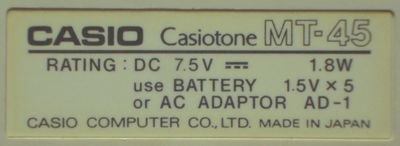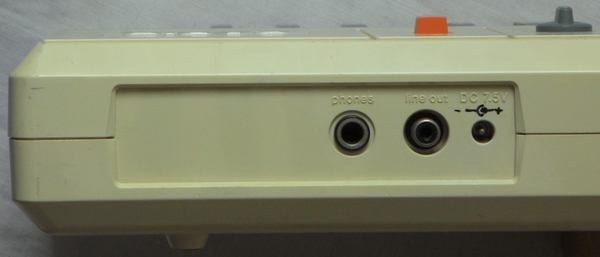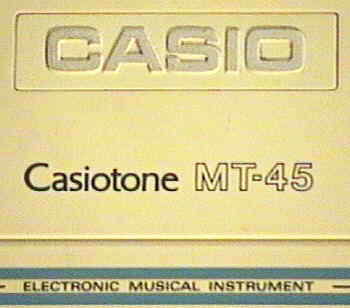 |
pretty
semi-analogue keyboard with arpeggio accompaniment |
|
This beautiful white Casio keyboard of 1982 (service manual date)
has wonderful warm semi-analogue sounds, arpeggio accompaniment and sonorous
droning multipulse squarewave bass tones resembling 'organ' on Hing-Hon
EK-001.

Despite its age, the MT-45 control panel design with its blue lines,
pastel coloured softline shaped knobs and switches looks still noble and
modern and resembles a bit the "Aqua" user interface theme of Apple
Macintosh computers.
This instrument was re-released as Casio MT-46 with red and less
pretty control panel ornaments.
main features:
-
49 midsize keys
-
8 note polyphony (but left keyboard section stays always in manual bass/
chord mode, thus only 31 keys usable for main voice)
-
4 note polyphony in chord section
-
separate knobs for main and rhythm + accompaniment volume
-
tempo knob
-
8 preset rhythms {pops, disco, 16beat, swing | samba, beguine, tango, waltz}
selected by a 4-step slider + switch
-
8 preset sounds {piano, elec. piano, organ, pipe organ | harp, accordion,
clarinet, violin} selected by a 4-step slider + switch
-
mode switch {manual bass, fingered, casio chord}
-
switch for 2 bass timbres (squarewave based)
-
arpeggio switch
-
chord memory switch (chords stay held after releasing key when on)
-
rhythm fill-in and synchro button
-
vibrato and sustain switch
-
multi-chip hardware:
-
main voice CPU "HD44140, 3A
43" (54 pin SMD) with timbres based on 2 layered multipulse squarewaves
with different digital envelopes; some are routed through a fixed lowpass
filter. It makes very warm and pleasant timbres, but the linear envelopes
end too soon, which makes piano- like tones sound truncated and less natural.
-
accompaniment CPU "NEC D930G
011, 8434XK" (80 pin SMD) which produces different multipulse squarewave
tones (partly with capacitor envelope) and trigger pulses for external
analogue drums.
-
analogue percussion {base, snare, open cymbal, close cymbal, woodblock}
with half- way metallic cymbal based on shift register feedback noises.
-
headphone and cinch output jacks
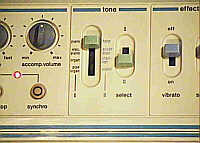 |
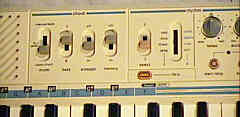 Note the elegant control panel design.
Note the elegant control panel design. |
 |
eastereggs:
This instrument employs the same very versatile accompaniment CPU like
the Casio CT-410V, thus there are
lots of keyboard matrix eastereggs available. (For technical details
see there)
4 additional rhythms (rock, latin swing, bossa nova, slow rock)
2 additional bass variations (III, IV)
3 additional accompaniment variations (II, III, IV)
3 additional arpeggio variations (II, III, IV)
1 lower & 5 higher additional main voice keys
On the PCB with the sound output jack are empty component holes for an
additional jack (volume pedal?). I didn't upgrade my MT-45 because
I already own the CT-410V, which had most of these features and
I enabled all the hidden ones.
modifications:
-
polarity protection diode added, power supply jack polarity corrected.
notes:
I bought this instrument in very dirty state, and during transport(?) the
plastic tab/ hook under one key cracked off from accidentally bending it
too far up. (I replaced the tab with a piece of insulated copper wire and
hotglue.) Someone had written the key names above the keys with blue Edding;
my attempt to remove them with isopropanol also damaged the blue and black
stripe pattern printed on the case there. Unusual with this keyboard is,
that the keys are made from separate plastic parts and not hanging on one
common, bendable plastic strip; thus I assume that it must be very old.
The silicone contacts below are also separate parts and were stained with
dirt and a sticky stuff (likely adhesive tape glue from the felt strip
above); although I cleaned all these parts thoroughly, the keys still don't
respond perfectly.
The MT-45 hardware employs the same very versatile
D930G
accompaniment CPU like the Casio CT-410V
(and many other Casio instruments), although here only few of its features
are used. Unfortunately it was combined with a foreign main voice CPU that
is too stupid to communicate with it (using its own keyboard matrix), so
the accompaniment section at the left half of the keyboard can not be switched
off, i.e. these keys can not be used for main voice play when neither chords
nor manual bass is wanted. The only benefit is that the polyphony is not
reduced by accompaniment.
This instrument plays high quality analogue timbres, those although
not always natural, reproduce a warm and very pleasant sound; it does not
sound typically C64- like thin, but resembles rather full- size home organs
of that era. Like with Casio VL-1,
the release phase of main voice envelopes seems to be linear and thus sounds
unrealistic since it fades silent too soon with audible end click. When
sustain is switched off, all sounds stop almost immediately after releasing
the key. With sustain on, sounds with decay envelope (piano, elec. piano,
harp) ignore the key press duration and sound always with a fixed duration
instead. The "elec. piano" sounds like a banjo, and also the normal piano
resembles more a picked string. The "harp" and "organ" sound like adding
a bit of analogue distortion during attack phase (it turned out to be indeed
a suboscillator with very short independent envelope).
The accompaniment is almost as flexible playable like the Testron
one, and thus also accepts any disharmonic note combinations and not just
those few ones that establishment has defined to be "chords". The available
styles on the MT-45 correspond to chord variation "I", bass variations
"I" & "II" and the default arpeggio (= variation "I"?) of my CT-410V.
The percussion of the MT-45 are analogue and resemble the CT-410V,
although it has 2 drums less than the latter. Interesting is that the MT-45
produces a much softer, duller and more pressureful bass than the CT-410V,
which timbre resembles a triangular wave or Roland TB303 (without
resonance), while the CT-410V bass is a more sonorous droning ordinary
squarewave tone. The MT-45 sounds also brighter than the initially quite
muffled CT-410V, and generally I find its timbre somehow fresher and clearer
and thus like it a bit better, despite the great CT-410V has far more capabilities.
By sound and functions the Casio MT-45 instrument is mostly comparable
with my Yamaha PS-2, but unlike the
latter it is not that extremely compact and features more rhythms, sounds
and nice sounding arpeggios. Even the internal speaker is of very reasonable
quality. I only yearningly miss independent volume control knobs for the
individual accompaniment voices (fortunately my CT-410V has them).
circuit bending details
The electronics of the MT-45 employs the same very versatile
D930G
accompaniment CPU like the Casio CT-410V
(and many other Casio instruments), although here only few features of
it are used. Unlike in many other Casio keyboards, here it is not
combined with the versatile D931C
main voice soundchip (that it was dedicated for?), but a foreign main voice
CPU "Hitachi HD44140" (same
like in the rhythmless
Casio MT-11) with only 8 preset sounds.
Unlike D931C, the HD44140 does not communicate at all with the D930G, but
uses a completely independent keyboard matrix for all main voice related
keys and switches. (Possibly Casio had not finished the D931C yet when
the MT-45 went in production.) Unfortunately this results in that
the accompaniment section at the left half of the keyboard can not be switched
off, thus these keys can not be used for main voice play when neither chords
nor manual bass is wanted. The only benefit is that so the polyphony is
not reduced by accompaniment. But the HD44140 supports only 37 keys anyway,
thus in a 49 keys instrument it would make little sense to circumvent this
by complicated external logics.
To the right of the HD44140 is a trimmer that seems to be the level
adjustment for the highest main voice bit. Another trimmer to its left
was omitted (empty solder holes), that was intended to tweak the level
ratio between low and higher bits to minimize distortion. The trimmer even
further left seems to set the main volume. The MT-45 has 2 strange black
square crystal oscillators. That at the D930G has a "6596, KSS3B" (PCB
mark "X1 (6.6M)"?) while that of HD44140 is printed "5752, KSS3A" (PCB
mark "X2 (5.7M). So I guess that the upper number is the frequency in kHz.
Casio likely used crystals here because else it would have been hard to
keep D930G and HD44140 play in tune with each other, because their clock
ratio of 1.14673157163:1 would be hard to produce by simple frequency dividers.
On the amp PCB there is a section of unused solder holes those look like
made for a sustain pedal jack (not supported by HD44140) or tuning trimmer
(not used due to crystal clock); its 3 unused foil cable solder pads go
into nowhere.
rhythm & accompaniment
About the rhythm and accompaniment section and the tons of hidden D930G
eastereggs see Casio CT-410V.
main voice keyboard matrix
The main voice is produced by the self-contained sound CPU Hitachi HD44140,
which has only few functions and runs completely independent from the accompaniment.
Very unusual for Casio is its keyboard matrix layout with 16 output and
only 3 input lines. Except 6 unused keys I found no eastereggs.
|
6 KC1
|
7 KC2
|
8 KC3
|
9 KC4
|
10 KC5
|
11 KC6
|
12 KC7
|
14 KC8
|
15 KC9
|
16 KC10
|
17 KC11
|
18 KC12
|
19 KC13
|
20 KC14
|
22 KC15
|
23 KC16
|
|
CPU pin
|
|
out 1
|
out 2
|
out 3
|
out 4
|
out 5
|
out 6
|
out 7
|
out 8
|
out 9
|
out 10
|
out 11
|
out 12
|
out 13
|
out 14
|
out 15
|
out 16
|
out / in
|
|
O.
clarinet
|
O.
organ
|
O.
harp
|
o
F#0
|
o
A0
|
o
C1
|
o
D#1
|
o
F#1
|
o
A1
|
o
C2
|
o
D#2
|
o
F#2
|
o
A2
|
o
C3
|
o
D#3
|
sustain
|
in 1
|
3 KI1
|
O.
violin
|
O.
pipe organ
|
O.
piano
|
o
G0
|
o
A#0
|
o
C#1
|
o
E1
|
o
G1
|
o
A#1
|
o
C#2
|
o
E2
|
o
G2
|
o
A#2
|
o
C#3
|
o
E3
|
vibrato
|
in 2
|
4 KI2
|
O.
accordion
|
O.
elec. piano
|
o
F0
|
o
G#0
|
o
B0
|
o
D1
|
o
F1
|
o
G#1
|
o
B1
|
o
D2
|
o
F2
|
o
G#2
|
o
B2
|
o
D3
|
o
F3
|
|
in 3
|
5 KI3
|
The input lines are active-low, i.e. react on GND. Any functions can
be triggered by a non- locking switch in series to a diode from one "in"
to one "out" pin.
legend:
|
|
|
"o"
|
= keyboard key |
|
underlined
|
= function needs locking switch (i.e. stays active only so long the
switch is closed) |
|
O.
|
= preset sound ('orchestra') |
orange
background |
= easteregg (unconnected feature) |
|
Despite the case shape and button layout of the MT-45 is identical
with the (older?) Casio MT-60, the
latter contains a much bigger PCB with totally different hardware, which
features far more sound presets but thinner sounding accompaniment.
| removal
of these screws voids warranty... |
|
|
 |

|
|
| |
back
|
|


 Note the elegant control panel design.
Note the elegant control panel design.

